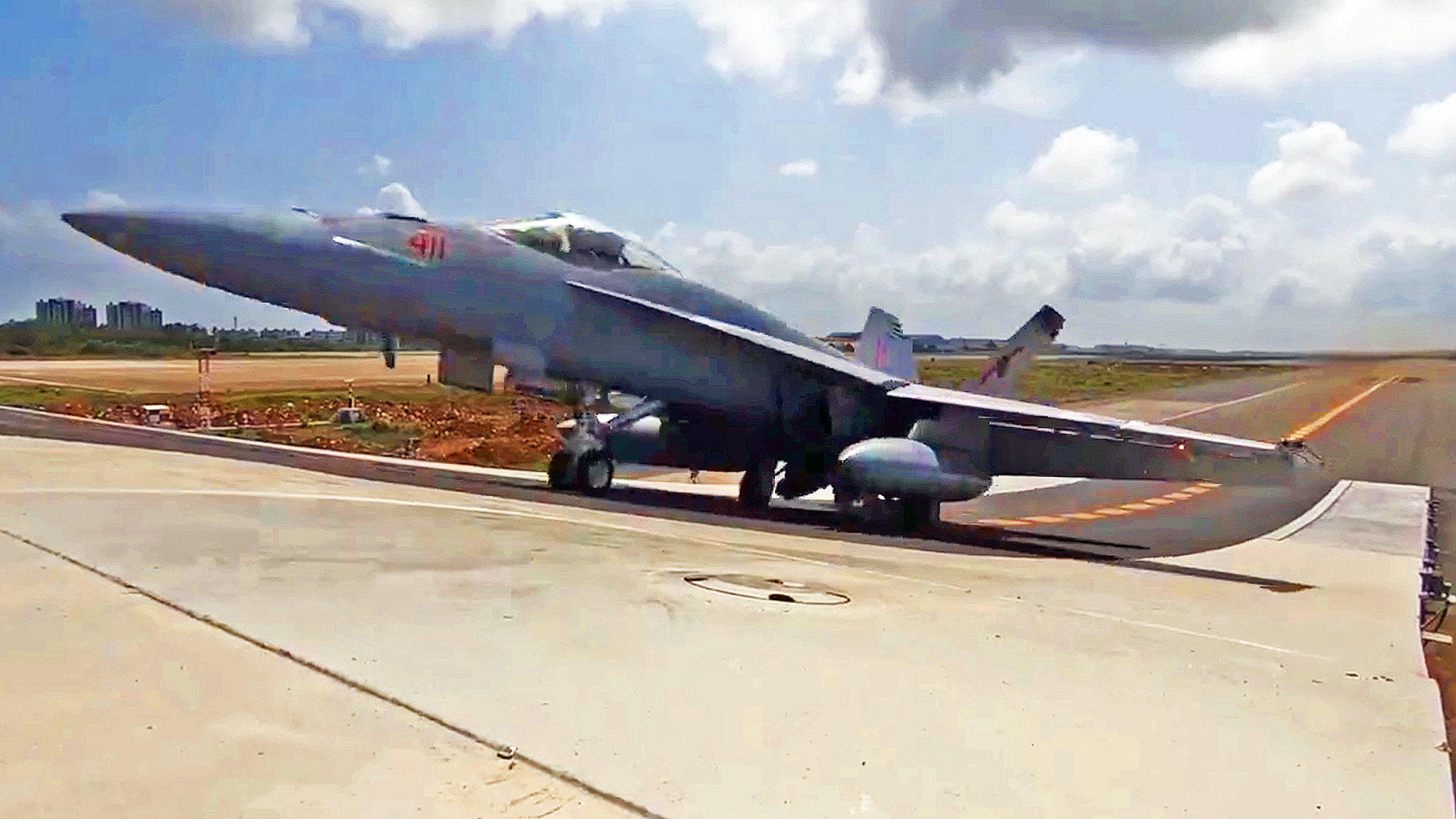Boeing announced that two F/A-18E Super Hornets have successfully completed operational demonstration tests at Indian Naval Station Hansa in Goa, India. The exercises were meant to prove the Super Hornet’s suitability to operate from Indian Navy carriers, which do not have catapults and are equipped with ski jumps instead. If the tests were indeed as successful as Boeing is declaring them to have been, they will likely push the company further along in the Indian Navy’s Multi-Role Carrier-Borne Fighter (MRCBF) competition.
According to a press release shared by Boeing, the pair of U.S. Navy F/A-18E Super Hornets, at least one of which belongs to the U.S. Navy’s Strike Fighter Squadron 25 (VFA-25) based on its markings, completed multiple ski jumps, roll-in and fly-in arrestments, as well as other performance flights in a variety of air-to-air, air-to-ground, and air-to-surface combat configurations.

The Super Hornet underwent similar tests in 2020 at Naval Air Station Patuxent River in Maryland when the fighter carried out eight ski jumps also in various configurations. The focus on demonstrating such capabilities is predominately due to the Indian Navy’s need for an aircraft that can operate from short take-off but arrested recovery configured (STOBAR) aircraft carriers like the country’s existing INS Vikramaditya and future INS Vikrant, the latter of which is scheduled to be commissioned this August.
Currently aboard the Indian Navy’s aircraft carriers are the Russian-made MiG-29K Fulcrums. If Boeing is to win the MRCBF contract, the Super Hornets would augment the existing Fulcrums as they are gradually phased out. The MiG-29K has not only failed to perform in ways that the Indian Navy needs, but the Fulcrum’s naval variant isn’t designed with the catapult-launch capability that India is looking for the MRCBF to provide.

This is because the Indian Navy is aiming to field catapult-assisted takeoff but arrested recovery (CATOBAR) configured aircraft carriers in the coming decade on top of its ski-jump equipped STOBAR carriers. However, the two Vikrant-class ships are scheduled to be completed before the Indian Navy makes the transition to CATOBAR-configured carriers. So, having a jet that is capable of utilizing catapults as well as the ramp is a fairly critical feature.
While the Indian Navy’s carrier fleet slowly but surely undergoes its significant makeover, the service’s MRCBF program is in place to ensure that it is supplemented with modern, multi-role air wings. After cutting the program’s tender from its initial goal of procuring 57 fighters down to just 26, the two big companies still in the running to win the Indian Navy’s carrier-based combat aircraft contract are Dassault Aviation and Boeing.

Boeing aims to address all of the carrier requirements outlined by the Indian Navy with the F/A-18 Block III Super Hornet, which you can read about in detail here. The new Block III configuration promises to notably broaden the Super Hornet’s capabilities both in general and as they pertain to the Indian Navy. Boeing’s pitch for the service lauds the Super Hornet’s demonstrated compliance with the country’s carriers. Among other characteristics, its optional two-seat configuration is ideal for controlling future unmanned carrier-borne aircraft. Most of all, it has the proven pedigree of a very mature design capable of carrying a huge array of weapons and it is the most widely deployed naval fighter on Earth by a huge margin.

Dassault Aviation and its French carrier-based Rafale M fighter jet contender began compatibility trials with the Indian Navy’s carriers at the start of this year. After 12 days of testing at India’s Naval Station Hansa facility in Goa last January, the highly sought-after ski-jump capability was reportedly successfully demonstrated by the Rafale M. It’s also important to note that in July 2020, the Indian Air Force received five land-based Rafale fighters as part of an $8.7 billion contract for 36 total aircraft, with the total delivery now complete. The fact that India’s Air Force already operates 36 new Rafales and has been a Dassault fighter jet customer for decades is definitely a plus for the Dassault team.

Boeing has highlighted the Super Hornet’s ability to interface with the P-8I Poseidon maritime patrol jet, 12 of which the Indian Navy has already purchased from Boeing with another six in the works. Another interesting fact that may or may not play into this competition is the Super Hornet’s ability to fold its wings, a design characteristic that the Rafale-M does not possess.

Boeing has also implemented a ‘For India – By India’ sustainment program, which would allow the Indian Navy to maintain the fighter fleet locally throughout its lifecycle. Other industrial offsets are part of both the French and U.S. offerings, as well.
While the prospects look bright for the Super Hornet in India, both fighters are very much in the running for the much-anticipated MRCBF contract. And if past Indian fighter procurement is any indication, pretty much anything can happen between now and when actual airframes enter production.
We will keep you informed as the competition progresses.
UPDATE:
A new image and video have been posted. The image shows arrestment trials with a Super Hornet loaded with two 500lb laser-guided bombs, AIM9Xs and AIM-120s, and a video of the pilots explaining the tests.

Contact the author: Emma@thewarzone.com
